OMB 1220-0025 Part B Final 7-23-2012
OMB 1220-0025 Part B Final 7-23-2012.doc
International Price Program U.S. Export and Import Price Indexes
OMB: 1220-0025
B. DESCRIPTIONS OF INFORMATION COLLECTION EMPLOYING STATISTICAL METHODS
The following paragraphs summarize the primary features of the sampling and statistical methods used to collect data and produce estimates for the IPP Export and Import series. Additional technical details are provided in Chapter 15 of the BLS Handbook of Methods (http://www.bls.gov/opub/hom/homch15_a.htm) and the Sampling and Index Construction Concepts papers, which are internal BLS reports and are available upon request.
1. Universe and Sample Size
The target universe of the import and export price indexes consists of all goods and services sold by U.S. residents to foreign buyers (exports) and purchased from abroad by U.S. residents (imports). However, items for which it is difficult to obtain consistent time series for comparable products (such as works of art) are excluded, as are goods purchased specifically for military use.
The import and export price indexes are calculated from prices submitted on a monthly basis by sampled establishments that agree to participate in the IPP’s Import/Export Price Index Survey at initiation. Thus, the IPP collects data from sampled establishments at initiation and during monthly repricing.
In the following, the unweighted response rates are presented for initiation and repricing.
The unweighted establishment quote response rate and frame error rate are equal to:
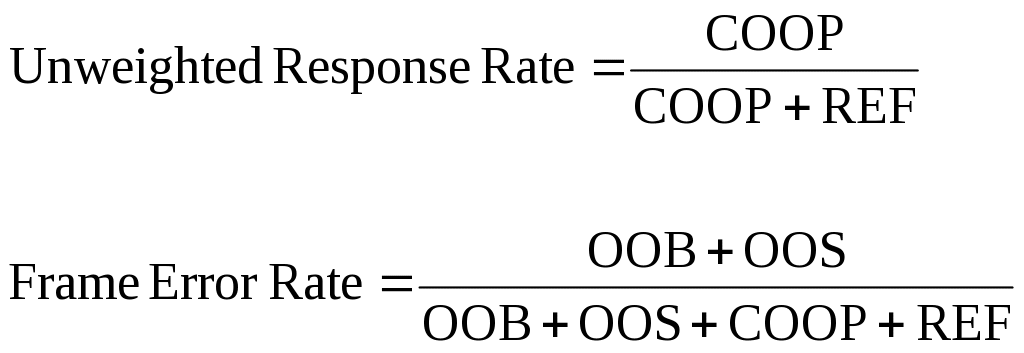
where:
COOP = the number cooperative quotes;
REF = the number of quotes coded as refusals;
OOS = the number of out-of-scope quotes; and
OOB = the number of out-of-business quotes
The unweighted establishment response rate and frame error rate are equal to:
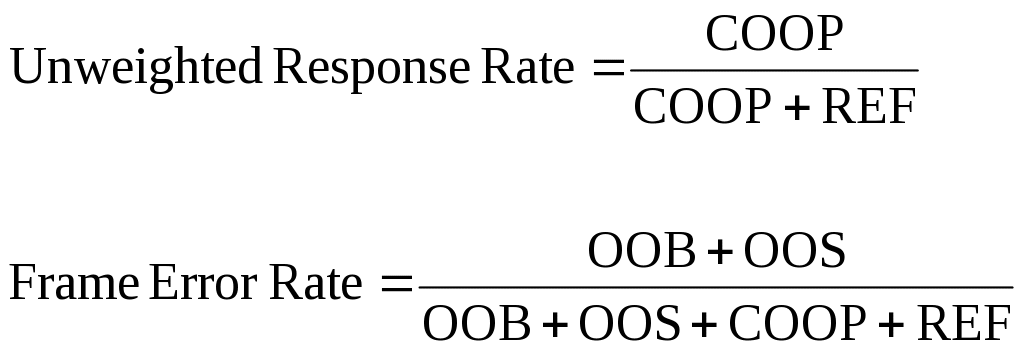
where:
COOP = the number of establishments with at least one cooperative quote;
REF = the number of establishments with no cooperative quotes and at least one quote
coded as a refusal;
OOS = the number of establishments with no quotes coded as cooperative or as refusals
and with at least one quote coded as out-of-scope; and
OOB = the number of establishments with all quotes coded as out-of-business
EXPORTS
To meet the demanding requirements of the IPP in the environment of the constantly changing composition of international trade requires complex statistical procedures. The universe consists of the total set of export prices. The number of establishments exporting products or services from the United States in the universe is approximately 500,000. In 2012, the overall sample for ongoing repricing of exports for the IPP is approximately 2,200 exporters with 17,600 annual prices/responses . Approximately 8 quotation prices are sampled within each exporter with a resultant average of 4.525 prices collected from each responding exporter. There are approximately 150 product category strata1 in the export sample design.
Export Response Rates at Initiation
The response rate achieved at the establishment-quote level during the last two export samples initiated was 63% excluding out‑of‑scope and out‑of‑business quotes. Approximately 31% of the sampled quotes are either out‑of‑scope or out‑of‑business.
The following table presents the unweighted establishment-quote response rates for exporters for IPP initiation.
Unweighted Response Rate at Establishment-Quote Level |
|||
Outcome |
X34 |
X35 |
Overall |
Cooperative |
64.3% |
61.8% |
63.1% |
Refusal |
35.7% |
38.2% |
36.9% |
-
Frame Error Rate at
Establishment-Quote Level
Outcome
X34
X35
Overall
In-Scope
71.8%
66.0%
68.9%
OOB/OOS
28.2%
34.0%
31.1%
The next table presents the number of quotes from the 34th and 35th exporter samples by initiation outcome code. These numbers were used to calculate the unweighted response rates at the establishment-quote level.
Export Quote Counts |
||||
Outcome |
X34 |
X35 |
Overall |
Percent |
Cooperative |
3915 |
3372 |
7287 |
43.5% |
Refusal |
2177 |
2087 |
4264 |
25.4% |
OOB |
191 |
184 |
375 |
2.2% |
OOS |
2202 |
2634 |
4836 |
28.9% |
Grand Total |
8485 |
8277 |
16762 |
100.0% |
The initiation response rate at the establishment level during the last two export samples was 80% excluding out‑of‑scope and out‑of‑business units. Approximately 22% of the sampled units are either out‑of‑scope or out‑of‑business. In addition, approximately 10% of the exporters selected in a sample are lost each year due to going out‑of‑business, further refusal, or the changing nature of the export business.
The following table presents the unweighted establishment response rates for exporters for IPP initiation based on the last two export samples. The overall response rate is based on the combined responses from the 34th exporter sample (X34) and 35th exporter sample (X35).
Unweighted Response Rate at Establishment Level |
|||
Outcome |
X34 |
X35 |
Overall |
Cooperative |
81.1% |
78.8% |
80.0% |
Refusal |
18.9% |
21.2% |
20.0% |
-
Frame Error Rate at
Establishment Level
Outcome
X34
X35
Overall
In-Scope
80.9%
74.4%
77.5%
OOB/OOS
19.1%
25.6%
22.5%
The next table presents the number of establishments from the 34th and 35th exporter samples by initiation outcome code. These numbers were used to calculate the unweighted export response rates at the establishment level.
Export Establishment Counts |
||||
Outcome |
X34 |
X35 |
Overall |
Percent |
Cooperative |
864 |
823 |
1687 |
62.0% |
Refusal |
202 |
221 |
423 |
15.5% |
OOB |
35 |
37 |
72 |
2.7% |
OOS |
217 |
322 |
539 |
19.8% |
Grand Total |
1318 |
1403 |
2721 |
100.0% |
Export Response Rates for Repricing
Once an establishment agrees to provide price data to the IPP at initiation, each unique item to be repriced for the establishment is loaded into the Repricing and Estimation portions of the IPP Unified Database. In most cases an item represents a single quote from one sample, but in some cases an item represents multiple quotes from a single sample, or one or more quotes from more than one sample. Following is a table of IPP repricing rates are calculated based on the unique items being repriced. The unweighted response rates for the repricing stage are shown in the table below from January 2009 – October 2011.
Export Response Rates for Repricing Stage |
||||
Reference Period |
1st Closing |
2nd Closing |
3rd Closing |
4th Closing |
200901 |
69% |
71% |
72% |
72% |
200902 |
69% |
71% |
71% |
72% |
200903 |
73% |
74% |
75% |
76% |
200904 |
72% |
75% |
76% |
76% |
200905 |
75% |
77% |
77% |
77% |
200906 |
76% |
78% |
78% |
78% |
200907 |
73% |
75% |
76% |
76% |
200908 |
74% |
75% |
76% |
76% |
200909 |
74% |
75% |
76% |
76% |
200910 |
74% |
76% |
77% |
77% |
200911 |
74% |
76% |
76% |
76% |
200912 |
77% |
78% |
78% |
79% |
201001 |
73% |
74% |
75% |
76% |
201002 |
74% |
76% |
77% |
77% |
201003 |
76% |
77% |
78% |
78% |
201004 |
76% |
77% |
78% |
78% |
201005 |
77% |
78% |
79% |
79% |
201006 |
76% |
77% |
77% |
77% |
201007 |
74% |
76% |
77% |
77% |
201008 |
75% |
77% |
78% |
78% |
201009 |
75% |
76% |
77% |
77% |
201010 |
74% |
76% |
76% |
76% |
201011 |
75% |
76% |
76% |
76% |
201012 |
75% |
76% |
77% |
77% |
201101 |
75% |
76% |
77% |
77% |
201102 |
75% |
76% |
77% |
77% |
201103 |
74% |
75% |
75% |
75% |
201104 |
71% |
73% |
74% |
74% |
201105 |
74% |
75% |
75% |
75% |
201106 |
74% |
75% |
75% |
75% |
201107 |
71% |
73% |
74% |
74% |
201108 |
73% |
74% |
75% |
75% |
201109 |
74% |
75% |
75% |
75% |
201110 |
73% |
74% |
74% |
75% |
In the above table, the data for the 1st Closing shows the percentage of items for which repricing data had been returned as of the time the index for that reference period was first published. The data for the 2nd Closing shows the return rate for the following month—when the data for that period was published for the second time. The response rate for the second closing includes all of the responses from the first closing and all the responses received after the first closing and before the second closing. Data for the 3rd and 4th Closings show return rates for the 3rd and 4th (or final) times that the index for these periods were computed and published. IPP finalizes the indexes for each time period at the time of the 4th closing, so this is the final rate for the period.
IMPORTS
To meet the demanding requirements of the IPP in the environment of the constantly changing composition of international trade requires complex statistical procedures. The universe consists of the total set of import prices. The number of establishments importing products or services into the United States is approximately 500,000. In 2012, the overall sample for ongoing repricing of imports for the IPP is approximately 3300 importers with 27,060 prices/responses. Approximately 8.2 quotation prices are sampled within each importer with a resultant average of 4.927 prices collected from each responding importer. There are approximately 150 product category strata in the import sample design.
Import Response Rates at Initiation
The response rate achieved at the establishment quote level during the last two import samples initiated was 67%. Approximately 25% of the sampled quotes are either out‑of‑scope or out‑of‑business. The following table presents the unweighted establishment-quote response rates at initiation.
Unweighted Response Rate at Establishment-Quote Level |
|||
Outcome |
M34 |
M35 |
Overall |
Cooperative |
68.6% |
65.1% |
66.9% |
Refusal |
31.4% |
34.9% |
33.1% |
|
|
|
|
Frame Error Rate at Establishment-Quote Level |
|||
Outcome |
M34 |
M35 |
Overall |
In-Scope |
75.3% |
74.1% |
74.7% |
OOB/OOS |
24.7% |
25.9% |
25.3% |
The next table gives the number of quotes from the 34th and 35th importer samples by initiation outcome code. These numbers were used to calculate the unweighted response rates at the establishment-quote level.
Import Quote Counts |
||||
Outcome |
M34 |
M35 |
Overall |
Percent |
Cooperative |
6988 |
6225 |
13213 |
50.0% |
Refusal |
3204 |
3330 |
6534 |
24.7% |
OOB |
367 |
316 |
683 |
2.6% |
OOS |
2976 |
3016 |
5992 |
22.7% |
Grand Total |
13535 |
12887 |
26422 |
100.0% |
The initiation response rate achieved at the establishment level during the last two import samples was 82%. Approximately 18% of the units sampled are either out‑of‑scope or out‑of‑business. In addition, approximately 10% of the importers selected in a sample are lost each year due to going out‑of‑business, further refusals, or the changing nature of the import business.
The following table gives the unweighted establishment response rates for importers for IPP initiation based on the last two import samples. The overall response rate is based on the combined responses from the 34th importer sample (M34) and 35th importer sample (M35).
Unweighted Response Rate at Establishment Level |
|||
Outcome |
M34 |
M35 |
Overall |
Cooperative |
84.5% |
79.9% |
82.2% |
Refusal |
15.5% |
20.1% |
17.8% |
-
Frame Error Rate at
Establishment Level
Outcome
M34
M35
Overall
In-Scope
81.6%
80.7%
81.2%
OOB/OOS
18.4%
19.3%
18.8%
The next table presents the number of establishments from the 34th and 35th importer samples by initiation outcome code. These numbers were used to calculate the unweighted import response rates at the establishment level.
Import Establishment Counts |
|||||
Outcome |
M34 |
M35 |
Overall |
Percent |
|
Cooperative |
1394 |
1325 |
2719 |
66.7% |
|
Refusal |
256 |
333 |
589 |
14.5% |
|
OOB |
60 |
56 |
116 |
2.8% |
|
OOS |
311 |
341 |
652 |
16.0% |
|
Grand Total |
2021 |
2055 |
4076 |
100.0% |
|
Import Response Rates for Repricing
Once an establishment agrees to provide price data to the IPP at initiation, each unique item to be repriced for the establishment is loaded into the Repricing and Estimation portions of the IPP Unified Database. In most cases, an item represents a single quote from one sample, but in some cases, an item represents multiple quotes from a single sample, or one or more quotes from more than one sample. Following is a table of IPP repricing rates are calculated based on the unique items being repriced. The unweighted response rates for the repricing stage are shown in the table below from January 2009 – October 2011 for each closing.
Import Response Rates for Repricing Stage |
||||
Reference Period |
1st Closing |
2nd Closing |
3rd Closing |
4th Closing |
200901 |
66% |
67% |
68% |
68% |
200902 |
68% |
69% |
70% |
70% |
200903 |
70% |
72% |
73% |
73% |
200904 |
71% |
72% |
73% |
73% |
200905 |
73% |
74% |
74% |
74% |
200906 |
73% |
74% |
75% |
75% |
200907 |
71% |
72% |
73% |
73% |
200908 |
72% |
74% |
74% |
74% |
200909 |
72% |
74% |
74% |
74% |
200910 |
71% |
72% |
73% |
73% |
200911 |
72% |
73% |
74% |
74% |
200912 |
73% |
74% |
75% |
75% |
201001 |
70% |
72% |
73% |
73% |
201002 |
72% |
74% |
74% |
74% |
201003 |
75% |
76% |
76% |
76% |
201004 |
74% |
75% |
76% |
76% |
201005 |
75% |
77% |
77% |
77% |
201006 |
75% |
76% |
76% |
76% |
201007 |
71% |
72% |
73% |
74% |
201008 |
73% |
74% |
75% |
75% |
201009 |
73% |
74% |
75% |
75% |
201010 |
73% |
75% |
76% |
76% |
201011 |
73% |
74% |
75% |
75% |
201012 |
73% |
74% |
75% |
75% |
201101 |
70% |
72% |
73% |
73% |
201102 |
71% |
73% |
73% |
73% |
201103 |
71% |
72% |
73% |
73% |
201104 |
69% |
71% |
72% |
72% |
201105 |
70% |
72% |
72% |
72% |
201106 |
71% |
73% |
73% |
74% |
201107 |
71% |
73% |
74% |
74% |
201108 |
73% |
75% |
75% |
76% |
201109 |
74% |
75% |
76% |
76% |
201110 |
73% |
74% |
75% |
75% |
In the table above, the data for the 1st Closing shows the percentage of items for which repricing data had been returned as of the time the index for that reference period was first published. The data for the 2nd Closing shows the return rate in the following month—when the data for that period was published for the second time. The response rate for the second closing includes all of the responses from the first closing and all the responses received after the first closing and before the second closing. Data for the 3rd and 4th Closings show return rates for the 3rd and 4th times that the index for these periods were computed and published. IPP finalizes the indexes for each time period at the time of the 4th closing, so this is the final rate for the period.
2. Collection Procedures
a. Description of Sampling Methodology
The import merchandise sampling frame is obtained from the U.S. Customs and Border Protection (USCBP). This frame contains information about all import transactions that were filed with the USCBP during the reference year. The frame information available for each transaction includes a company identifier (usually the Employer Identification Number), the detailed product category (Harmonized Tariff number) of the goods that are being shipped, and the corresponding dollar value of the shipped goods.
The export merchandise sampling frame is obtained from the U.S. Census Bureau for exports to the world except Canada. These exports are filed on an electronic computer system known as the Automated Export System (AES). . Since exporters trading with Canada no longer need to file export documentation, the IPP uses the Canadian import documents provided to the U.S. Census Bureau from the Canadian Customs Service. The constructed frame contains information about all export transactions that were filed during the reference year. The frame information available for each transaction includes a company identifier (usually the Employer Identification Number), the detailed product category (Harmonized Tariff number) of the goods that are being shipped, and the corresponding dollar value of the shipped goods.
The IPP divides both its import and export universes into two halves referred to as panels based on trade dollar value. The program samples one import panel and one export panel each year. Those samples are sent to the field offices for collection, so that both universes are fully re-sampled every two years. The sampled products are priced for approximately five years until the items are replaced by a newly drawn sample from the same panel. As a result, each published index is based upon the price changes of items from up to three different samples.
For exports, the two panels consist of the following major product groupings, as defined by the Harmonized System:
Export Product Panel A: Food and beverages
Minerals, chemicals, and rubber
Crude materials; related goods
Miscellaneous manufactures
Export Product Panel B: Machinery
Vehicles and transportation equipment
For imports, the two panels consist of the following major product groupings, as defined by the Harmonized System:
Import Product Panel A: Food and Beverages
Crude materials; related goods
Vehicles and transportation equipment
Miscellaneous manufactures
Import Product Panel B: Minerals, chemicals, and rubber
Machinery
Each panel is sampled using a three stage sample design. The first stage selects establishments independently proportional to size (dollar value) within each broad product category (stratum) identified within the Harmonized classification system (HS).
The second stage selects detailed product categories (classification groups) within each establishment – stratum using a systematic probability proportional to size (PPS) design. The measure of size is the relative dollar value adjusted to ensure adequate coverage for all three published strata across all classification systems, and known non-response factors (total company burden and frequency of trade within each classification group). Each establishment - classification group (or sampling group) can be sampled multiple times and the number of times each sampling group is selected is then referred to as the number of quotes requested.
In the third and final stage, the Field Economist, with the cooperation of the company respondent, performs the selection of the actual items for use in the IPP indexes. Using the entry level classification groups selected in the second stage, a list of items is provided by the respondent to the Field Economist. Using a process called disaggregation, items are selected from this list with replacement to satisfy the number of item quotes requested for each entry level classification group.
b. Description of Estimation Methodology
The IPP uses the items that are initiated and repriced every month to compute its price indexes. These indexes are calculated using a modified Laspeyres index formula. The modification used by the IPP differs from the conventional Laspeyres index by using a chained index instead of a fixed-base index. Chaining involves multiplying an index (or long term ratio) by a short term ratio (STR). This is useful since the product mix available for calculating price indexes can differ over time (Bobbitt, 2007).
The conventional Laspeyres index and the modified index are identical as long as the market basket of items does not change over time and each item provides a usable price in every period. In fact, due to non-response, the mix of items used in the index from one period to the next is often different. The benefits of chaining over a fixed base index include a better reflection of changing economic conditions, technological progress, and spending patterns, and a suitable means for handling items that are not traded every calculation month.
Below is the derivation of the modified fixed quantity Laspeyres formula used in the IPP.
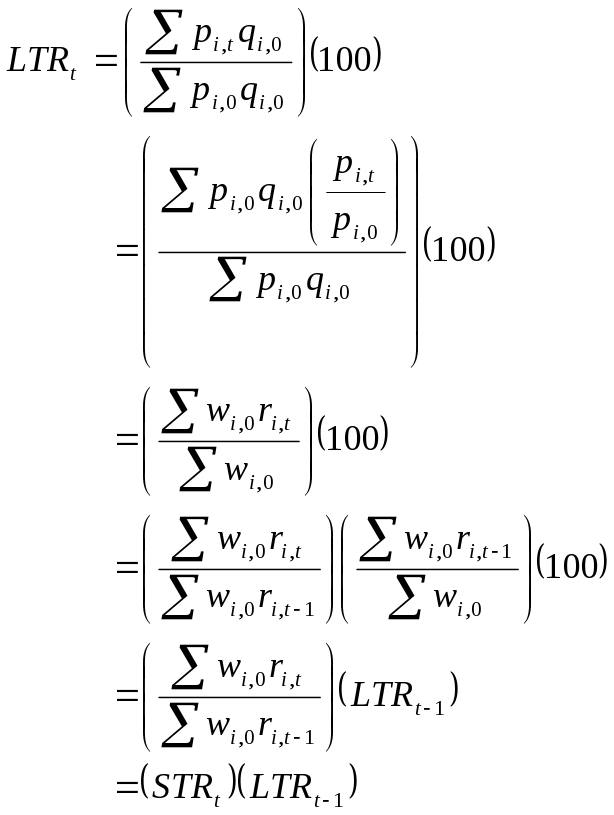
where:
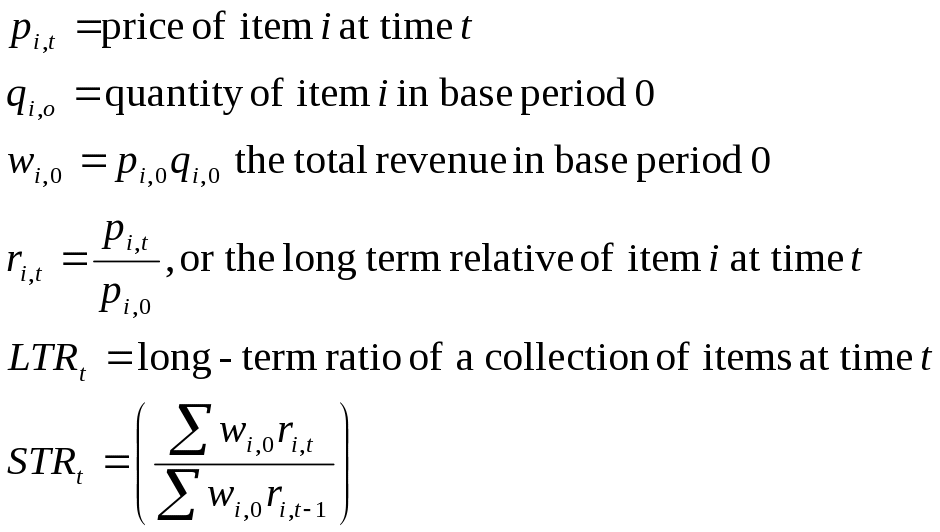
For each classification system, the IPP calculates its estimates of price change using an index aggregation structure (i.e. aggregation tree) with the following form (Powers, 2006):
Upper Level Strata
Lower Level Strata
Classification Groups
Weight Groups (i.e. Company-Index Classification Group)
Items
A stratum may have several middle-level-strata between itself and the classification group level or none. The number of middle-level-strata from the classification group to each stratum varies depending on which stratum the specific CG belongs. Similarly, the number of middle-step-strata from a stratum lower to an overall index varies. The following general formula is used until the desired aggregation level index is obtained.
Let
Child[h]
to be the set of all strata or classification groups in the
aggregation level directly below Stratum h
in
an aggregation tree. Let
![]() be
a short-term ratio of stratum,
be
a short-term ratio of stratum,![]() ,
at time
,
at time![]() :
:
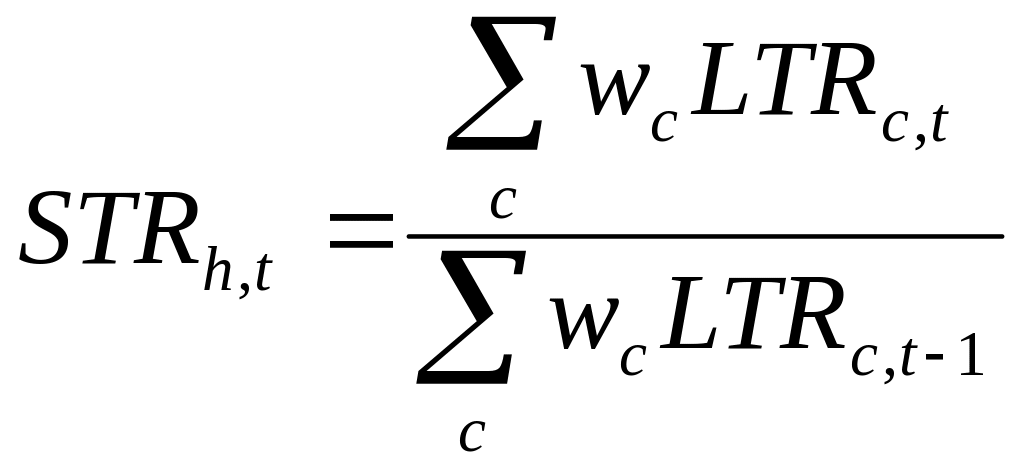
where:

As mentioned previously, at any given time, the IPP has up to three samples of items being used to calculate each stratum's index estimate. Currently the IPP combines the data from these samples by ‘pooling’ the individual estimates.
Pooling refers to combining items from multiple samples at the lowest level of the index aggregation tree. These combined sample groups are referred to as a weight group. Different sampling groups can be selected for the same weight group across different samples, so it is possible that multiple items from different sampling groups can be used to calculate a single weight group index. This weight group level aggregation is done primarily so the Industry Analysts within IPP can perform analyses on the index information across samples.
3. Methods to Maximize Response Rates
Several techniques are used to ensure maintenance of adequate sample sizes for estimating IPP indexes. Initial sample sizes are sufficiently larger than desired sample sizes to allow for non‑response (which includes out‑of‑business, out‑of‑scope, and refusal outcomes). An export analysis and an import analysis were conducted to identify the causes of out‑of‑scope non-response, which resulted in the methodology changes below. (For additional details, see the Out-of-Scope Export and Import Analysis reports which are internal BLS reports available upon request.)
A paneling approach was implemented whereby a new sample is introduced each
year across half the product categories, re‑establishing the distribution of the
sample and incorporating changes in the distribution of exports/imports.
Frequency of trade of exporters/importers in products is measured from the
sampling frame and incorporated in the sample design to reduce the
out‑of‑scope rate.
For exports, the IPP now receives name and address information for each export
shipment from a company and has revised its matching process for determining
the correct name and address of each sampled unit.
IPP has also recently implemented linking the Employer Identification Number
(EIN) to additional data sources and using the linked information for identifying
the correct name, address, and other pertinent information of each sampled unit.
Additionally, other variables on the sampling frame were examined for aid in
identifying out-of-scope trade. As a result of this analysis, the IPP now screens
(from its sampling frame) transactions that contain values for these variables that
identify out-of-scope shipments.
The IPP is currently conducting a Pilot study to determine the productivity of
allowing initiation of a sampled product area to occur at a broader (six-digit
Harmonized) level when the original initiation at the more detailed ten-digit
Harmonized level resulted in an out-of-scope situation. The results of this study
will be completed in 2012.
To improve the response rate of respondents, the IPP has devised strategies to reduce respondent burden while increasing or at least maintaining their level of participation. The strategies which the IPP has implemented include the following:
capping the burden for a respondent within a sample
enhancing the sampling refinement process so that Industry Analysts have more
freedom to reduce the burden for a respondent when needed; and
items.
4. Testing Procedures and Plans
The Program has implemented several changes to reduce respondent burden (discussed under number 3 in parts A and B of the Supporting Statement) and has identified proposals which upon implementation, may further reduce burden. However, IPP has no testing related to reducing respondent burden scheduled for the foreseeable future.
5. Statistical Contacts
The responsibility for the statistical aspects of the International Price Program as well as collection and processing of price information, resides with William Alterman, Assistant Commissioner for International Prices, Office of Prices and Living Conditions, Bureau of Labor Statistics.
References
Bobbitt, P.A., Paben, S.P., Cho, M.J., Himelein, J.A., Chen, T-C., and Ernst, L.R.(2007). Application of the Bootstrap Method in the International Price Program. 2007 Proceedings of the American Statistical Association, Survey Research Methods Section [CD-ROM], 2910-2917
Bobbitt, P. A, Cho, M. J. and Eddy, R. M.(2005). Comparing Weighting Methods in the International Price Program. 2005 Proceedings of the American Statistical Association, Government Statistics Section [CD-ROM], 1006-1014
Chen, T-C., Bobbitt, P.A., Himelein, J.A., Paben, S.P., Cho, M.J., and Ernst, L.R.(2007). Variance Estimation for International Price Program Indexes. 2007 Proceedings of the American Statistical Association, Survey Research Methods Section [CD-ROM], 1427-1434
Cho, M. J. and Eltinge, J. L.(2008). Evaluation of Error Components in a Simulation Based Evaluation of a Survey Procedure. 2008 Proceedings of the American Statistical Association [CD-ROM], 352-359
Cho, M. J., Chen, T-C, Bobbitt, P.A., Himelein, J.A., Paben, S.P., Ernst, L.R., and Eltinge, J. L.(2007). Comparison of Simulation Methods Using Historical Data in the U.S. International Price Program. 2007 Proceedings of the American Statistical Association, Third International Conference on Establishment Surveys [CD-ROM], 248-255
Fitzgerald, Jenny(2009). Assessing Nonresponse Bias in the International Price Program’s (IPP) Import and Export Price Index Surveys. 2009 Proceedings of the American Statistical Association, Survey Research Methods Section [CD-ROM], 2070-2082
Kravis, Irving B. and Lipsey, Robert E. (1971). Price Competitiveness in World Trade.
Powers, R., Eltinge, J. L. and Cho, M. J.(2006). Evaluations of the Detectability and Inferential Impact of Nonresponse Bias in Establishment Surveys. 2006 Proceedings of the American Statistical Association, Survey Research Methods Section [CD-ROM], 3577-3583
11 IPP uses the term “stratum” (pl. “strata”) to refer to a grouping of one or more classification groups which are homogenous with
respect to some characteristic and may experience similar price trends.
| File Type | application/msword |
| File Title | Supporting Statement |
| Author | Courtney Elizabeth Lam |
| Last Modified By | lam_c |
| File Modified | 2012-07-12 |
| File Created | 2012-07-12 |
© 2025 OMB.report | Privacy Policy